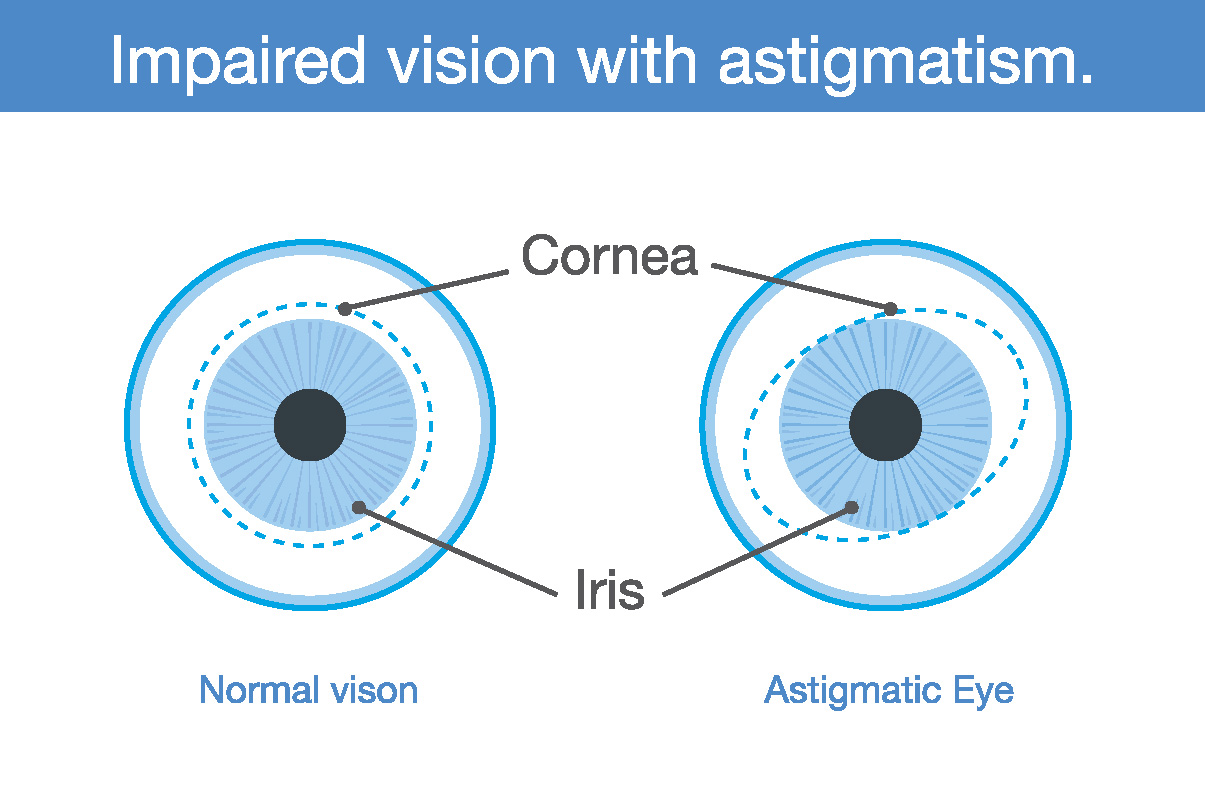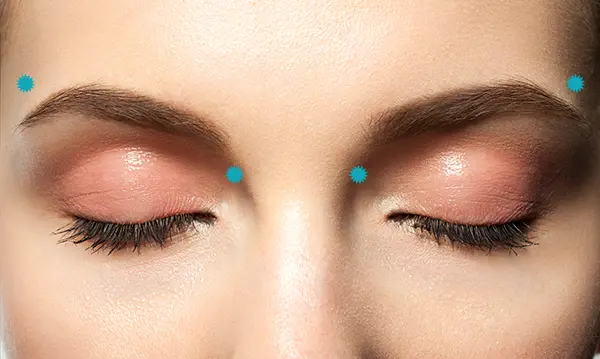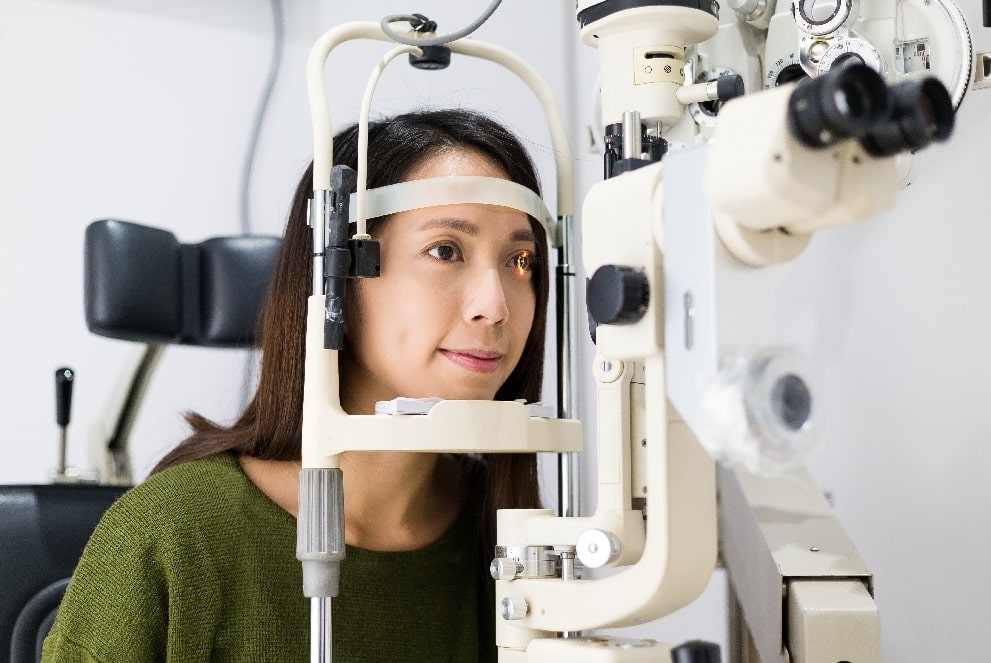Introduction

Comparison between a normal eye and an astigmatic eye – light does not focus evenly, causing blurred and distorted vision.
Astigmatism occurs when the cornea or lens has an irregular curvature, causing light to focus unevenly on the retina. People with astigmatism often see blurred, distorted, or stretched images. This refractive error commonly accompanies myopia or hyperopia.
Causes of Astigmatism
Astigmatism usually stems from irregularities in the cornea. When the cornea loses its perfectly round shape, light scatters as it enters the eye, causing unclear images on the retina. Patients may experience blurred, distorted vision, particularly noticeable when driving at night.
Common causes include:
- Genetics: Children with parents who have astigmatism are more likely to develop it. In some cases, pressure from the eyelids may also alter corneal shape.
- Keratoconus: The cornea thins and bulges outward into a cone shape, leading to irregular refraction of light.
- Eye injuries: Trauma, foreign objects, or sports-related accidents can scar the cornea, altering its surface.
- Corneal degeneration: Age-related changes in corneal structure may result in astigmatism.
- Surgical complications: Certain refractive procedures may leave the cornea deformed, contributing to astigmatism.
7 Eye Exercises for Astigmatism

Massage exercises around the eyes help relax, reduce fatigue, and support patients with astigmatism.
The following eye exercises cannot replace medical treatment, but they can help relax the eyes, reduce strain, and slow down the progression of astigmatism.
Eye massage
Close your eyes and gently move your index fingers in circular motions around the eyeballs for about one minute. This simple massage helps relax the surrounding muscles, stimulates blood circulation, and eases eye fatigue after long hours of reading or screen exposure. It can also reduce the feeling of heaviness in the eyes.
Eye relaxation
With your eyes closed, use three fingers to rotate gently in both clockwise and counterclockwise directions. Repeat ten times on each side. This technique not only relieves tension but also reduces stress accumulated in the eye muscles. It is especially beneficial for those who spend extended periods in front of computers or smartphones.
Near and far focus
Choose a small object such as a pen, focus on it for a few seconds, then shift your gaze to a distant point. Repeat this cycle several times daily. This exercise trains the eye’s focusing system, enhancing its flexibility and helping reduce eye strain. It is particularly helpful for people with astigmatism who often struggle with blurred transitions between distances.
Blinking exercise
Close your eyes for five seconds, then open them for five seconds. Repeat multiple times. Blinking stimulates tear production, keeps the cornea moist, and prevents dryness. Since many people blink less when concentrating on screens, this exercise restores the natural rhythm and protects against dry eye syndrome.
Tracing the figure-eight
Visualize or draw a large figure-eight on a wall or piece of paper, and move your eyes along its outline for about forty seconds. This exercise improves eye coordination, strengthens visual tracking, and enhances flexibility. Practicing regularly helps reduce the distortion caused by astigmatism.
Clockwise eye movement
Hold your thumb about ten centimeters from your nose and move your gaze as if following the positions of a clock (3, 6, 9, and 12 o’clock). This movement relaxes the eye muscles, improves circulation within the ocular area, and restores natural focusing ability. Doing this several times a day can help the eyes recover after prolonged concentration.
Reading with distant breaks
While reading, pause every five minutes to look at distant objects for about ten seconds before continuing. This practice prevents continuous close-range stress on the eyes, reduces strain, and helps maintain sharper vision. It is especially useful for students and office workers who spend long hours reading or working with documents.
Precautions When Practicing
Always wash your hands before touching your eyes to prevent infections. The best time for these exercises is in the evening before bedtime so your eyes can rest fully. Nutrition also plays a role: include vitamin A, C, E, and Omega-3 from carrots, leafy greens, and salmon. Most importantly, schedule eye exams every six months to monitor your condition.
Effective Treatment Options for Astigmatism

Regular eye exams help detect and monitor astigmatism early, ensuring proper treatment.
While exercises help relax the eyes, they cannot cure astigmatism. Patients should consult eye care specialists such as those at TD Eye for effective treatment.
Prescription glasses or contact lenses are common solutions for mild cases. Laser surgery options like LASIK, PRK, or SMILE are suitable for patients with thick corneas. For those with thin corneas or severe astigmatism between 1–4 diopters combined with high myopia, Phakic ICL (Phakic ICL, Toric ICL) offers a safe, advanced solution. This technique involves implanting a Collamer lens inside the eye, preserving corneal structure and allowing removal if needed.
Numerous international studies confirm that Phakic ICL provides stable, sharp vision both day and night, with 99.4% patient satisfaction.
In general, stigmatism eye exercises are useful for relieving tension and reducing eye strain, but they cannot replace medical treatment. For long-term, safe results, schedule regular check-ups and consider advanced options like Phakic ICL. At TD Eye, experienced doctors and international technology ensure optimal care, helping you regain clear and healthy vision.

 vi
vi 24-Sep-2025
24-Sep-2025











 0916.741.763
0916.741.763 Appointment
Appointment